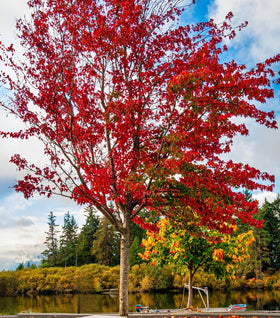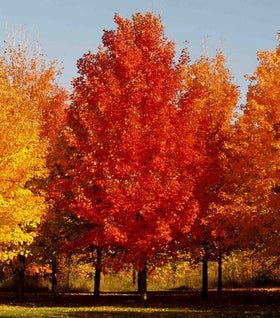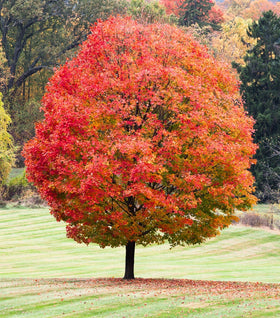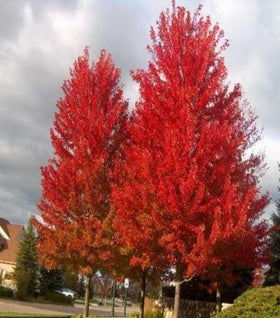Maple Trees for Sale Online
Maple trees have been providing beauty and shade to the American landscape for many years. Some Maple Trees can grow to heights of more than 70 feet. Maples produce unique, vibrant fall colors in shades of yellow, red, orange, and burgundy. Maple trees are fast-growing shade trees and are very easy to maintain. Maple Trees are the number one planted shade tree in America.
There is a wide range of Maple Tree varieties that will complement any landscape, including many hybrids. There are nearly endless options to choose from, from the statuesque Red Maple to the iconic Sugar Maple trees. If you are in the market for a smaller Maple, check out our large selection of Japanese Maples, many of which are perfect for smaller landscapes.
How to Use Maple Trees in the Landscape
Maple trees are favorites in the home and commercial landscape setting, especially in the North-Eastern part of the United States. These trees add vibrant color and glossy leaves throughout the growing season. They provide much-needed shade and can be planted in just about any soil type and prefer full sun to partially shaded locations.
Maple trees also attract a variety of birds and wildlife into the yard. Many birds find the maple's strong horizontal branching structure perfect for nesting. When you see how the local wildlife reacts to having healthy trees for maple's using them as protection, you'll wonder why everyone isn't planting trees.
Maples trees, in general, are considered understory trees. This means that they prefer to grow in filtered sunlight under the shade of larger forest trees; however, some Maples love the full sun. In the Southern US States and high mountain areas such as Utah, Colorado, and Montana, care should be taken to locate maple trees to receive protection from the hot midday sun.
One of my favorite indicators of springs arrival is looking out over the forests in our area in the late winter and noticing color start to emerge in the treetops. Maples flower in late winter/early spring as the sap starts to flow. I refer to the maples in the front yard as my spring gauge.
Take a look around in the late winter, right when you are starting to wonder if spring will ever arrive, and I bet you'll see red in the tops of the maples, and you'll know spring is close.
Popular types of Maple Trees:
Red Maples: Red maple trees are also known as Swamp maples. They are very popular because of their fabulous color. They are native to North America, and cultivars such as Autumn Blaze and October Glory are perfect for lawns of all sizes and provide shade quickly due to their fast growth rates. Red maples can reach heights of 50 to 60 feet tall.
Brandywine Maple: This is a special Maple in that its flowers are male-only, which means none of the annoying "helicopters" that turn into seedlings in landscape beds. Smaller in size than other maples, only reaching 35 feet tall and 20 feet wide.
Silver Maples: These are fast-growing maples often seen growing near creeks and waterways. Unfortunately, they are often damaged in high winds or ice storms common in the northeast without proper and frequentIt'sniIt's
Japanese Maples are perhaps the most easily recognized maple tree primarily due to their red color. They are most often used as specimen trees in landscapes. Japanese maples are smaller than their North American cousins.
Why plant Maple trees?
Maple trees are easy to grow, sturdy, long-lived, and typically low maintenance. In addition to the brilliant fall color, maple trees also have a beautiful shape to compliment any laIt'sape setting.
One of the most significant benefits of maple trees includes shading the sunny side of your home to help keep the home cooler in the summer. In the fall, the leaves drop to let the winter sun heat the house.
When planting young maple trees, be sure not to bury the root ball below the soil line regardless of the species. We always say that you should still see the potting soil after planting.
Maple Trees are among the fastest-growing shade trees available. Their attractive fall colors are a perfect way to add color to any garden, and they will bring permanence to your property and provide beautiful year-round interest for homeowners, especially those in the Northern United States.
Red maple trees, with their beautiful fall colors and branching structure. Available in multiple sizes and colors. Maple trees are easy to care for and provide a flexible solution for homeowners of all gardening skills.
Planting trees in your yard not only adds beauty to your yard but also increases the value of the property as well.
Easy to Grow Maple Trees
Autumn Blaze Maple: Autumn Blaze Maple Tree is an improved hybrid with brilliant, long-lasting orange-red fall foliage, a uniform branching habit, and a rapid growth rate. Thrives in warm climates thriving well into the south and west; will tolerate wet soils with good drainage.
Autumn Flame Maple: An excellent addition to any landscape, the Autumn Flame Red Maple brings a vibrant red orangWoodie's to any yard. It's a moderate-growing maple that has a distinguished fall color on the iconic three-pronged maple leaf.
Brandywine Red Maple: Brandywine Red Maple is a male selection. This means it can be used in the landscape without fear of seedlings popping up all around the landscape.
October Glory Maple: October Glory Maple is an outstanding shade Tree. The Green Leaves turn from bright orange to deep, reddish-purple color in the fall. It's a tall tree with a dense, rounded crown. Foliage is held on the tree later into fall than with most other maples.
If you are looking for a tree that will add brilliant color during the bleak days of fall, look no further than a maple. With proper planting and care, the tree will dress up the landscape for years to come, and between the many types, there's a maple suitable for everyone's desires.
How Fast do Maple Trees grow?
Most maple trees grow about 2 feet per year under ideal conditions. There are faster-growing maples like silver maple, autumn blaze maple, and October glory maple that can grow 3 to 5 feet in a single year.
Maple trees are an excellent addition to any garden, and Garden Goods Direct can provide quality specimens from a convenient source. As America's number one online garden center, we help you with anything you need to get suitable trees for your garden. We offer an easy online ordering solution and expert advice on tree care. You'll know you're getting quality every time you shop with us.
If you're looking to buy Maple Trees online for your garden, consider Woodie's approved Maple Trees from Garden Goods Direct. We provide you with the trees you want. We also help you with Maple planting tips to make the most of your investment.
Our trees are grown and shipped in containers. We do not ship trees bare-root, ensuring you'll receive a perfectly grown tree with a healthy undamaged root system.
Can I Make Maple Syrup From A Maple?
Technically, you can make maple syrup from any maple tree, excluding Japanese maples. However, different maple trees from North America have different length 'sugaring seasons' -windows of time to collect good sap. Also, different types of trees have vastly different sugar concentrations in their sap. Sugar Maples are used the most to make commercial maple syrup. Red Maples, including October Glory Maples, have the second-highest sugar concentration but a very short window of time to collect sap in comparison to Sugar Maples.
Do Maple Trees Have Helicopter Seeds?
Yes, there are types of maple trees that produce samaras, or the slightly reddish seeds that move through the breeze using a single helicopter wing.
How Can I Prevent Frost Cracks or Winter Damage?
Sometimes temperature fluctuations in winter between freezing cold, unseasonably warm, and back to freezing can cause cracking on young trees with thinner bark such as Red Maples. Sunny days and freezing nights can also create this environment. Or, if the south-facing side of a tree gets more sun than the north side, the trunk bark can crack if only part of the trunk thaws, and this is sometimes called sunscald.
If you live in grow zones where this happens, you can take measures to prevent cracks. Wrap your young tree trunks with a light-colored cloth or tree-wrap in the winter. This will help reflect light away from the tree in the winter and help the tree maintain a more even temperature throughout the season. Don't try to fix or paint a crack that has already happened, simply watch the area closely for pests or other issues. Remove the wrap as soon as spring begins and temperatures even out.




